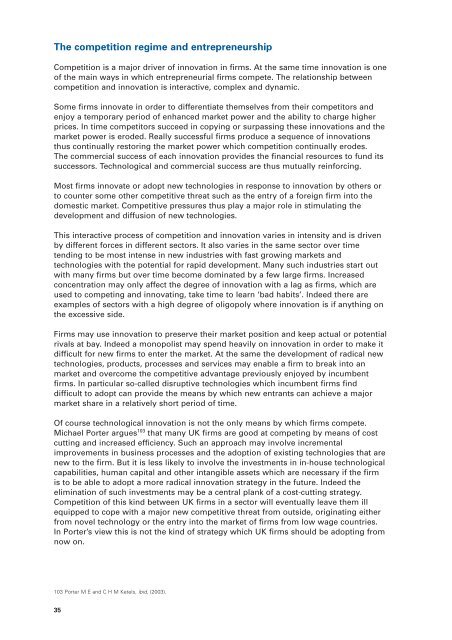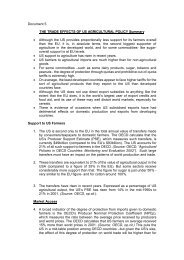Competing in the Global Economy – The Innovation Challenge
Competing in the Global Economy – The Innovation Challenge
Competing in the Global Economy – The Innovation Challenge
You also want an ePaper? Increase the reach of your titles
YUMPU automatically turns print PDFs into web optimized ePapers that Google loves.
<strong>The</strong> competition regime and entrepreneurship<br />
Competition is a major driver of <strong>in</strong>novation <strong>in</strong> firms. At <strong>the</strong> same time <strong>in</strong>novation is one<br />
of <strong>the</strong> ma<strong>in</strong> ways <strong>in</strong> which entrepreneurial firms compete. <strong>The</strong> relationship between<br />
competition and <strong>in</strong>novation is <strong>in</strong>teractive, complex and dynamic.<br />
Some firms <strong>in</strong>novate <strong>in</strong> order to differentiate <strong>the</strong>mselves from <strong>the</strong>ir competitors and<br />
enjoy a temporary period of enhanced market power and <strong>the</strong> ability to charge higher<br />
prices. In time competitors succeed <strong>in</strong> copy<strong>in</strong>g or surpass<strong>in</strong>g <strong>the</strong>se <strong>in</strong>novations and <strong>the</strong><br />
market power is eroded. Really successful firms produce a sequence of <strong>in</strong>novations<br />
thus cont<strong>in</strong>ually restor<strong>in</strong>g <strong>the</strong> market power which competition cont<strong>in</strong>ually erodes.<br />
<strong>The</strong> commercial success of each <strong>in</strong>novation provides <strong>the</strong> f<strong>in</strong>ancial resources to fund its<br />
successors. Technological and commercial success are thus mutually re<strong>in</strong>forc<strong>in</strong>g.<br />
Most firms <strong>in</strong>novate or adopt new technologies <strong>in</strong> response to <strong>in</strong>novation by o<strong>the</strong>rs or<br />
to counter some o<strong>the</strong>r competitive threat such as <strong>the</strong> entry of a foreign firm <strong>in</strong>to <strong>the</strong><br />
domestic market. Competitive pressures thus play a major role <strong>in</strong> stimulat<strong>in</strong>g <strong>the</strong><br />
development and diffusion of new technologies.<br />
This <strong>in</strong>teractive process of competition and <strong>in</strong>novation varies <strong>in</strong> <strong>in</strong>tensity and is driven<br />
by different forces <strong>in</strong> different sectors. It also varies <strong>in</strong> <strong>the</strong> same sector over time<br />
tend<strong>in</strong>g to be most <strong>in</strong>tense <strong>in</strong> new <strong>in</strong>dustries with fast grow<strong>in</strong>g markets and<br />
technologies with <strong>the</strong> potential for rapid development. Many such <strong>in</strong>dustries start out<br />
with many firms but over time become dom<strong>in</strong>ated by a few large firms. Increased<br />
concentration may only affect <strong>the</strong> degree of <strong>in</strong>novation with a lag as firms, which are<br />
used to compet<strong>in</strong>g and <strong>in</strong>novat<strong>in</strong>g, take time to learn ‘bad habits’. Indeed <strong>the</strong>re are<br />
examples of sectors with a high degree of oligopoly where <strong>in</strong>novation is if anyth<strong>in</strong>g on<br />
<strong>the</strong> excessive side.<br />
Firms may use <strong>in</strong>novation to preserve <strong>the</strong>ir market position and keep actual or potential<br />
rivals at bay. Indeed a monopolist may spend heavily on <strong>in</strong>novation <strong>in</strong> order to make it<br />
difficult for new firms to enter <strong>the</strong> market. At <strong>the</strong> same <strong>the</strong> development of radical new<br />
technologies, products, processes and services may enable a firm to break <strong>in</strong>to an<br />
market and overcome <strong>the</strong> competitive advantage previously enjoyed by <strong>in</strong>cumbent<br />
firms. In particular so-called disruptive technologies which <strong>in</strong>cumbent firms f<strong>in</strong>d<br />
difficult to adopt can provide <strong>the</strong> means by which new entrants can achieve a major<br />
market share <strong>in</strong> a relatively short period of time.<br />
Of course technological <strong>in</strong>novation is not <strong>the</strong> only means by which firms compete.<br />
Michael Porter argues 103 that many UK firms are good at compet<strong>in</strong>g by means of cost<br />
cutt<strong>in</strong>g and <strong>in</strong>creased efficiency. Such an approach may <strong>in</strong>volve <strong>in</strong>cremental<br />
improvements <strong>in</strong> bus<strong>in</strong>ess processes and <strong>the</strong> adoption of exist<strong>in</strong>g technologies that are<br />
new to <strong>the</strong> firm. But it is less likely to <strong>in</strong>volve <strong>the</strong> <strong>in</strong>vestments <strong>in</strong> <strong>in</strong>-house technological<br />
capabilities, human capital and o<strong>the</strong>r <strong>in</strong>tangible assets which are necessary if <strong>the</strong> firm<br />
is to be able to adopt a more radical <strong>in</strong>novation strategy <strong>in</strong> <strong>the</strong> future. Indeed <strong>the</strong><br />
elim<strong>in</strong>ation of such <strong>in</strong>vestments may be a central plank of a cost-cutt<strong>in</strong>g strategy.<br />
Competition of this k<strong>in</strong>d between UK firms <strong>in</strong> a sector will eventually leave <strong>the</strong>m ill<br />
equipped to cope with a major new competitive threat from outside, orig<strong>in</strong>at<strong>in</strong>g ei<strong>the</strong>r<br />
from novel technology or <strong>the</strong> entry <strong>in</strong>to <strong>the</strong> market of firms from low wage countries.<br />
In Porter’s view this is not <strong>the</strong> k<strong>in</strong>d of strategy which UK firms should be adopt<strong>in</strong>g from<br />
now on.<br />
103 Porter M E and C H M Ketels, ibid, (2003).<br />
35
















